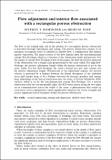Flow adjustment and interior flow associated with a rectangular porous obstruction
Author(s)
Rominger, Jeffrey Tsaros; Nepf, Heidi
DownloadNepf_Flow Adjustment_6-13-12.pdf (846.1Kb)
PUBLISHER_POLICY
Publisher Policy
Article is made available in accordance with the publisher's policy and may be subject to US copyright law. Please refer to the publisher's site for terms of use.
Terms of use
Metadata
Show full item recordAbstract
The flow at the leading edge and in the interior of a rectangular porous obstruction is described through experiments and scaling. The porous obstruction consists of an emergent, rectangular array of cylinders in shallow flow, a configuration that mimics aquatic vegetation. The main features of the flow depend upon the non-dimensional canopy flow-blockage, which is a function of the obstruction width and porosity. For the ranges of canopy flow-blockage tested in this paper, the fluid decelerates upstream of the obstruction over a length scale proportional to the array width. For high flow-blockage, the interior adjustment length within the porous obstruction is set by the array width. For low flow-blockage, the array's frontal area per unit volume sets the interior adjustment length. Downstream of the adjustment regions, the interior velocity is governed by a balance between the lateral divergence of the turbulent stress and canopy drag, or by a balance between the pressure gradient and canopy drag, depending on the lateral penetration into the array of Kelvin–Helmholtz (KH) vortices, which is set by the non-dimensional canopy flow-blockage. For a porous obstruction with two stream-parallel edges, the KH vortex streets along the two edges are in communication across the width of the array: a phenomenon that results in cross-array vortex organization, which significantly enhances the vortex strength and creates significant lateral transport within the porous obstruction.
Date issued
2011-06Department
Massachusetts Institute of Technology. Department of Civil and Environmental EngineeringJournal
Journal of Fluid Mechanics
Publisher
Cambridge University Press
Citation
Rominger, Jeffrey T., and Heidi M. Nepf. “Flow Adjustment and Interior Flow Associated with a Rectangular Porous Obstruction.” Journal of Fluid Mechanics 680 (2011): 636–659.
Version: Final published version
ISSN
0022-1120
1469-7645